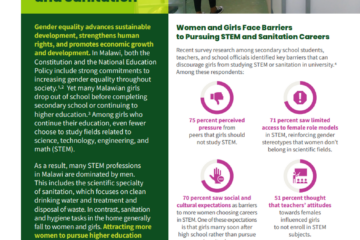
Maternal Mortality in Guatemala: A Preventable Tragedy
Date
June 9, 2003
Author
(June 2003) From instituting new maternal health policies to addressing the quality of health services for pregnant women and their newborns, Guatemala is taking a number of steps to try to reduce deaths and disability related to pregnancy, delivery, and postpartum complications. In 2000, 651 women died from these causes and many more were injured. In other words, two women died from pregnancy-related causes every day in this Central American nation of 12 million people, where the total fertility rate is estimated at roughly five children per woman.1
Estimates from the latest Baseline Maternal Mortality study show that 153 women die from maternity-related complications for every 100,000 live births. The region with the most dire situation is sub-Saharan Africa, where one in every 13 women risks dying of pregnancy-related causes during her lifetime, compared with 1 in more than 4,000 in industrialized countries (see Table 1). More than a social and health problem, a mother’s death is a family tragedy.
Table 1
Women’s Lifetime Risk of Death From Pregnancy, 1995
| Region | Lifetime Risk of Death |
|---|---|
| Sub-Saharan Africa | 1 in 13 |
| South Asia | 1 in 54 |
| Middle East and North Africa | 1 in 55 |
| Latin America and the Caribbean | 1 in 157 |
| East Asia/Pacific | 1 in 283 |
| Central East Europe/Commonwealth of Independent States and Baltic States | 1 in 797 |
| Industrialized countries | 1 in 4,085 |
Source: World Health Organization (WHO), United Nations Children’s Fund (UNICEF), and United Nations Population Fund (UNFPA), Maternal Mortality in 1995: Estimates developed by WHO, UNICEF and UNFPA (2001).
The Situation for Guatemalan Women Today
“Maternal mortality is an indication of the extreme harm some women suffer during their reproductive lives, the low availability and quality of health services, poor social conditions, malnutrition, and the consequences of women’s marginalized status,”2 according to the 1995 Demographic and Health Survey for Guatemala. These women generally die at home and have little access to skilled health care.3 Maternal mortality affects women from all economic and social strata, but a disproportionate number of those affected live in poverty, have little education, and live in rural areas.4 In Guatemala, the majority of deaths are among indigenous women with little education, women who work at home, and women who have two or more children.
Indigenous women have the most precarious living conditions, the highest fertility rates, and the smallest percentage of births attended by doctors or nurses (see Table 2). The maternal mortality ratio for this group is three times higher (211 per 100,000 live births) than for the nonindigenous group (70 per 100,000 live births), according to the Baseline Maternal Mortality study for 2000. Nationally, the departments where maternal mortality is above the national average are Alta Verapaz and Petén (north region), Sololá and Totonicapán (southwest), Huehuetenango and El Quiché (northwest), and Izabal (northeast).
Table 2
Percentage of Births Attended by Doctors or Nurses, Guatemala
| 1987 | 1995 | 1998-1999 | |
|---|---|---|---|
| All women | 34 | 35 | 41 |
| Indígena | 16 | 12 | 17 |
| Ladina | 48 | 52 | 55 |
Note: “Indígena” refers to women following a traditional, indigenous lifestyle. Ladina women are of any race and live a “Western” lifestyle.
Sources: Encuesta Nacional de Salud Materno Infantil 1987, 1995, 1998-1999.
More than half of maternal deaths are due to excessive bleeding. Others are due to infections, hypertension induced by pregnancy, and to unsafe abortion.5 (Abortion is illegal in Guatemala.) The Baseline Maternal Mortality study shows, among other things, that the majority of maternal deaths occur at home.
Government Actions To Address Maternal Mortality
To address these issues, the Guatemalan Congress enacted the Social Development Act in October 2001. The act establishes that the lives and health of mothers and children are a matter of public welfare and that healthy maternity is a national priority.6 The act calls for the creation of health care units capable of handling obstetric emergencies to be located at strategic sites throughout the country, particularly in places with the highest levels of maternal and child deaths.
The Population and Social Development Policy created to comply with the act aims to achieve an initial 15 percent reduction in maternal mortality.7 The body responsible for achieving this goal as well as other health advances — the National Reproductive Health Program — identifies high maternal mortality as one of the most important issues in the country. However, meeting the objective requires a strategy that involves not only the health sector but also various local and international bodies already working in the Maternal Health Monitoring Group.
One of the most recent achievements of the National Reproductive Health Program is the Baseline Maternal Mortality Study, conducted with UN agencies, governmental and nongovernmental organizations, and local universities brought together under the Maternal and Neonatal Health Monitoring Group.8 The study responded to the need to establish a real baseline for measuring the impact of actions taken to reduce maternal mortality.
The recommendations that emerged from the baseline study and which are in “Strategic Guidelines for Reducing Maternal Mortality” are meant to coordinate institutional and social efforts for an integrated response to maternal mortality. They take into account the many causes of the problem and the gender, ethnic, social, and cultural issues women face.
The National Reproductive Health Program has also produced a manual that standardizes the provision of health services at all levels of care.9 It discusses community, family, and user participation, and incorporates the concept of comprehensive reproductive health. This publication is supplemented by protocols intended to “standardize basic diagnostic and therapeutic procedures allowing institutional personnel to provide efficient, quality care to people who need the services.”10
Support From the Maternal and Neonatal Health Project
In Guatemala, the Maternal and Neonatal Health (MNH) project supports the government in promoting practices and services vital to the survival of the mother and newborn. All of its activities are coordinated with the Health Quality Project, headed by the University Research Corporation and a number of partners, with technical assistance from the U.S. Agency for International Development (USAID).11
At the heart of the MNH strategy is an accreditation program for maternal and neonatal health service networks called CaliRed (or “QualiNetwork”). This program is implemented through a performance and quality improvement approach for achieving desired institutional and individual performance. This approach provides the framework and tools to implement, measure, and evaluate improvements at facilities that deliver essential maternal and newborn health care services.
Setting Standards for Care
The criteria for measuring quality at the network of facilities (including health posts, health centers, and district hospitals) are the basis for the accreditation process. The community-defined quality dimensions include the following:
- Access to a maternity facility in the community;
- Treatment that is delivered in a respectful and timely fashion;
- Respect for traditional practices and use of indigenous languages; and
- A clean and well-equipped facility; transportation; and free services.12
The first step is to use the criteria to collect baseline measures of facility quality. This information is used to establish which are interventions to ensure improvements in the facilities, with the goal of accreditation. Each facility is reassessed after six to nine months to note improvements; if it achieves a satisfactory percentage of the criteria for quality, it receives official accreditation as a quality site for essential maternal and newborn care. When enough district facilities meet the quality standards, accreditation is awarded to the whole health services network of that district.13
As of December 2002, the accreditation process was underway at 153 health facilities, 12 hospitals, 41 health centers, and 125 health outposts.14 In 143 health facilities, new clinical practices were introduced in delivery, postpartum, and newborn care, while nursing schools received teaching support with a new focus on basic skills. Furthermore, communities are receiving municipal support to upgrade obstetric and neonatal emergency services.15
The National Postabortion Care Plan, put in place two years ago by the Epidemiological Research Center in Sexual and Reproductive Health (CIESAR), provides another channel for reducing maternal mortality. A diagnostic study was also done by CIESAR; the study is the first of three parts of a strategic approach developed by the World Health Organization to improve access to and quality of basic services in sexual and reproductive health. The first stage focuses on arriving at a strategic diagnosis of the current situation and planning specific actions. The emphasis is also on developing recommendations for changing or modifying current health policies, programs, and interventions, and identifying research needs. The emphasis of the second stage will be research and action. The most significant recommendations developed during the first stage are tested and evaluated for the design of health interventions. During the third stage, these interventions will be replicated and implemented on a larger scale.
Nancí Franco de Méndez is a population, health, and media specialist, based in Guatemala.
References
- Ministerio de Salud Pública y Asistencia Social (MSPAS), Línea basal de mortalidad materna para el año 2000 (Guatemala City: MSPAS, 2003).
- Instituto Nacional de Estadística (INE) et al., Encuesta Nacional de Salud Materno Infantil 1995 (Guatemala City: INE, 1995).
- MSPAS, Línea basal de mortalidad materna para el año 2000.
- Pan American Health Organization (PAHO), Regional Strategy for Maternal Mortality and Morbidity Reduction (Washington, DC: PAHO, 2002), accessed online at www.paho.org/english/gov/ce/spp/spp36-08-e.pdf, on March 10, 2003.
- MSPAS, Línea basal de mortalidad materna para el año 2000.
- Ley de Desarrollo Social, article 26, no. 5 (Guatemala City: October 2001).
- Secretaría de Planificación y Programación de la Presidencia (SEGEPLAN), Política de desarrollo social y población (Guatemala City: SEGEPLAN, April 2002).
- The organizations brought together under the Maternal and Neonatal Health Monitoring Group include the Ministry of Public Health and Social Welfare (MSPAS), the National Reproductive Health Program (PNSR), the Health Information Management System (SIGSA), Support for Health Sector Reform–European Union, the Epidemiological Research Center in Sexual and Reproductive Health (CIESAR), Johns Hopkins Project for International Education in Gynecology and Obstetrics/Maternal and Neonatal Health (JHPIEGO/MNH), United Nations Mission in Guatemala, PAHO, United Nations Children’s Fund (UNICEF), USAID, Secretaría Presidencial de la Mujer (SEPREM), Medical Entomology Research and Training Unit of the Universidad del Valle/CDC, United Nations Population Fund (UNFPA), University Research Corporation, National Office on Women, Guatemalan Gynecology and Obstetrics Association, Universidad Rafael Landívar, Universidad del Valle de Guatemala, Universidad de San Carlos, and the World Health Organization.
- PNSR, Lineamientos y normas de salud reproductiva, a publication of the PNSR with support of the Canadian government and UNFPA.
- MSPAS, Protocolos de salud reproductiva (Guatemala City: MSPAS, January 2003).
- Maternal and Neonatal Health Program, “Guatemala Ministerial Agreement Will Scale Up Performance and Quality Improvement Initiative,” NMH News (February 2002), accessed online at www.mnh.jhpiego.org/news/gtmoh.asp, on April 23, 2003.
- Maternal and Neonatal Health Program, “Country Profiles: Guatemala,” accessed online at www.mnh.jhpiego.org/where/guatemala1.asp, on April 23, 2003.
- Maternal and Neonatal Health Program, “Guatemala Ministerial Agreement Will Scale Up Performance and Quality Improvement Initiative.”
- Information supplied by USAID on advances in national formative and operative policy for pregnancy, childbirth, postpartum, and newborn care.
- Information provided by the Maternal and Neonatal Health Program, JHPIEGO Corporation, Guatemala.
For more on maternal mortality in the developing world, read PRB’s report Making Motherhood Safer: Overcoming Obstacles on the Pathway to Care (PDF: 734KB).





